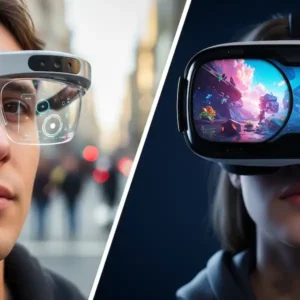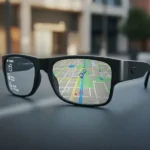AR vs VR Glasses: Blurring the Lines, Defining the Experiences
Augmented Reality (AR) and Virtual Reality (VR) are often grouped under the umbrella of “extended reality” (XR), but these two transformative technologies offer distinct experiences and cater to different needs. While both involve eyewear that manipulates your perception of reality, understanding their fundamental differences is key to appreciating their diverse applications. Learn more about the differences between AR vs VR glasses and the full XR experience.
This article will delve into the core distinctions between AR glasses and VR glasses and explore the exciting ways they are being used across various industries.
The Core Distinction: Immersion vs. Augmentation
The most significant difference between AR and VR lies in how they interact with your perception of the real world:
- Virtual Reality (VR) Glasses: Total Immersion, New Worlds VR glasses are designed to completely immerse you in a digitally created environment. When you put on a VR headset, your view of the physical world is entirely blocked out, replaced by a 360-degree virtual world. This aims to trick your senses into believing you are truly present in this new digital space.
- How they work: VR headsets typically feature high-resolution screens placed close to your eyes, along with lenses that create a wide field of view and the illusion of depth. Motion sensors track your head movements, adjusting the virtual environment in real-time to match your perspective. Many VR systems also include hand controllers for interacting with the virtual world, and some incorporate haptic feedback for a more realistic sensory experience.
- Analogy: Imagine stepping into a portal that transports you to a completely different place, whether it’s a fantastical landscape, a historical city, or a virtual meeting room.
- Augmented Reality (AR) Glasses: Enhancing Reality, Digital Overlays AR glasses, on the other hand, overlay digital information onto your view of the real world. You still see your physical surroundings, but digital elements like images, text, 3D models, or videos are seamlessly integrated into your line of sight. AR aims to enhance your existing reality rather than replace it.
- How they work: AR glasses typically use transparent lenses or displays that allow you to see through to the real world while projecting digital content. Cameras and sensors capture your environment, and software processes this data to accurately place virtual objects within that space. Interaction often occurs through hand gestures, voice commands, or eye-tracking.
- Analogy: Think of it like having a sophisticated heads-up display that provides contextual information or virtual objects directly in your field of vision, all while you remain fully aware of your physical environment.
Key Differences at a Glance:
Respective Applications: Where Do They Shine?
Both AR and VR are revolutionizing various sectors, but their distinct natures make them ideal for different applications:
Virtual Reality (VR) Glassses Applications:
- Gaming and Entertainment: This is perhaps the most well-known application. VR offers unparalleled immersive gaming experiences, virtual concerts, and interactive storytelling.
- Training and Simulation: From surgical training for doctors and flight simulations for pilots to military drills and heavy machinery operation, VR provides a safe, controlled, and cost-effective environment to practice complex skills without real-world risks.
- Education: Students can explore historical sites, dissect virtual organs, or journey through the solar system, making learning highly engaging and experiential.
- Virtual Tours and Travel: Explore distant lands, walk through historical landmarks, or view real estate properties without leaving your home.
- Therapy and Phobia Treatment: VR is used to create controlled environments for exposure therapy, helping individuals overcome fears and anxieties.
- Design and Prototyping: Architects can walk through virtual buildings, and engineers can visualize and manipulate 3D models of products before physical construction.
- Social Interaction & Remote Work: Platforms like Meta Horizon Worlds or VR meeting spaces allow for more engaging and presence-rich virtual gatherings, reducing travel needs for businesses.
Augmented Reality (AR) Glasses Applications:
- Retail and E-commerce: “Try before you buy” experiences, allowing customers to virtually place furniture in their homes (IKEA Place) or try on clothes and makeup.
- Navigation and Tourism: AR can overlay directions onto your real-world view, provide information about landmarks as you look at them, or offer real-time language translation.
- Maintenance and Repair: Field technicians can receive step-by-step instructions overlaid onto equipment, guiding them through complex repairs and reducing errors. Remote experts can also provide assistance by annotating a technician’s view in real-time.
- Healthcare: Surgeons can overlay patient data (like X-rays or CT scans) onto the body during operations, improving precision. AR also aids in vein finding for injections and medical training.
- Manufacturing and Assembly: Workers can receive visual cues and digital models for assembly tasks, improving efficiency and quality control on factory floors.
- Education and Training (Practical): Instead of fully simulated environments, AR can provide interactive overlays for hands-on training, such as guiding someone through assembling a complex machine.
- Marketing and Advertising: Engaging AR filters on social media, interactive product advertisements that bring digital elements into your physical space.
- Everyday Utility: Smartphone AR apps for measuring objects, identifying plants, or translating text on the fly. Future AR glasses could provide instant notifications, contextual information about people you meet, or even live calorie counts as you eat.
The Current Landscape: What’s Available Now?
The market for AR and VR eyewear is dynamic and rapidly evolving.
- VR Headsets: Dominated by standalone devices like the Meta Quest series (Quest 2, Quest 3), which offer untethered experiences and a vast library of games and applications. Other notable players include Sony PlayStation VR2 (for console gaming), HTC Vive (often favored for enterprise and high-end PC VR), and Pico headsets. Apple’s recent entry with the Vision Pro blurs the lines into mixed reality, emphasizing high-fidelity passthrough video to blend digital content with the real world, though its primary experience can be highly immersive.
- AR Glasses: The consumer market for true AR glasses is still nascent but growing. Microsoft HoloLens remains a leading enterprise-focused device, known for its robust capabilities in industrial and medical settings. Newer contenders like the Xreal Air (previously Nreal Air) offer lighter, more consumer-friendly designs, primarily functioning as portable external displays that can overlay content, bridging the gap between smart glasses and full AR. Google, Meta, and other tech giants are heavily investing in developing future generations of consumer AR glasses that are truly discreet and powerful.
- Smartphone AR: It’s important to remember that most people experience AR today through their smartphones and tablets. Platforms like Apple’s ARKit and Google’s ARCore enable millions of users to engage with AR apps for games, filters, shopping, and more, serving as a crucial stepping stone to dedicated AR eyewear.
Challenges and Limitations
Despite their immense potential, both AR and VR face significant hurdles:
- Cost: High-end VR headsets and especially sophisticated AR glasses can be prohibitively expensive for many consumers and even some businesses.
- Comfort and Form Factor: VR headsets can still be bulky, heavy, and cause “VR sickness” (motion sickness) for some users. AR glasses, while generally lighter, need to become indistinguishable from regular eyewear to achieve mass adoption.
- Battery Life: Powering the complex processors and displays in these devices demands substantial battery life, which is often a limiting factor, particularly for portable AR glasses.
- Content and Ecosystems: While VR gaming has a decent library, robust and compelling content is still developing for both platforms, particularly for enterprise and everyday utility applications. Developer tools and ecosystems are still maturing.
- Privacy Concerns: The integration of cameras and sensors in AR glasses, constantly observing the real world, raises significant privacy implications that need to be addressed through regulation and ethical design.
- Technical Hurdles (AR): Achieving wide field-of-view, bright, high-resolution displays in a small, transparent form factor remains a significant engineering challenge for true AR glasses. Accurate real-time environment mapping and object occlusion are also complex.
The Future of Reality Eyewear: Blurring the Lines with Mixed Reality

The trajectory of both AR and VR points towards Mixed Reality (MR). MR aims to seamlessly blend the digital and physical worlds, allowing virtual objects to interact convincingly with real-world environments and vice-versa. Devices like the Apple Vision Pro exemplify this direction, using high-resolution passthrough video to create a sense of digital content being truly present in your room.
Imagine a future where:
- Your AR glasses project a virtual TV screen on any wall, resizing it with a glance.
- You collaborate with colleagues who appear as realistic holograms in your living room, even if they’re across the globe.
- Educational AR experiences allow you to virtually dissect a frog on your kitchen table, with digital organs responding to your actions.
As processing power increases, display technology improves, and AI integration becomes more sophisticated, we will see AR and VR converge into a singular, versatile XR platform. The goal is to move beyond mere screen replacement to truly intelligent digital companions that augment our senses and interactions with the world.
Choosing Your Reality: Which is Right for You?
The “best” eyewear depends entirely on your needs and desired experience:
- Choose VR if you:
- Want complete immersion in virtual worlds for gaming, entertainment, or deep simulation.
- Are looking for a powerful tool for specific training, design, or therapeutic applications that require a distraction-free environment.
- Are comfortable with a larger form factor for now.
- Choose AR (or explore smartphone AR) if you:
- Want to enhance your real-world experiences with digital information.
- Need hands-free access to data, navigation, or visual aids while staying aware of your surroundings.
- Are interested in subtle, contextual information delivery throughout your day.
- Prioritize portability and the ability to seamlessly switch between digital and physical views.
Ultimately, both AR and VR represent paradigm shifts in human-computer interaction. As these technologies mature and become more accessible, they promise to unlock unprecedented ways to experience information, interact with our surroundings, and connect with each other, reshaping our digital and physical realities in profound ways.
Additional helpful information
More information about how smart glasses use AR – How Smart Glasses Use Augmented Reality
Authoritative External Sources
General Overviews and Differences
- Coursera: “Augmented Reality vs. Virtual Reality: What’s the Difference?”
- Intel: “Virtual Reality vs. Augmented Reality vs. Mixed Reality”
Uses and Applications
- SMU (Southern Methodist University): “Virtual Reality vs Augmented Reality: Comparative Analysis”
- Imaginovation: “Applications of AR & VR: Explained with Examples”
The Future of Reality
- CNET: “The Future Beyond Meta Quest and Vision Pro Is Coming in Glasses Form. What Will VR Look Like Then?”
- Ciklum: “AR/VR Trends and Predictions For 2025 & Beyond”




